Introduction: Exploring the Richness of Gumbo recipe
Gumbo, a dish steeped in history and bursting with flavor, stands as a testament to the culinary diversity of Southern cuisine. This article dives into the intricate world of gumbo, unraveling its secrets from traditional recipes to modern twists. We’ll embark on a journey through its ingredients, preparation methods, and cultural significance, ensuring readers gain a comprehensive understanding of this beloved dish.
Part 1: The Essence of Gumbo recipe: Ingredients and Preparation
Understanding Gumbo’s Core Components
Gumbo isn’t just a meal; it’s a symphony of flavors that reflects the melting pot of cultures in the American South. At its heart are the ‘holy trinity’ of bell peppers, onions, and celery, mingling with a variety of meats like chicken, sausage, and seafood. The secret to its rich, deep flavor lies in the roux, a carefully cooked mixture of flour and fat that defines its base.
Roux: The Backbone of Flavor
Making a roux is an art. It’s the foundation upon which the complex layers of gumbo’s flavor are built. You must stir this mixture of flour and oil patiently until it reaches a dark, chocolatey hue. The color of the roux not only imparts a rich flavor but also thickens the gumbo, giving it its characteristic hearty consistency.
The Magic of Seasoning and Spices
Spices are the soul of gumbo. From the earthy notes of thyme and bay leaves to the warmth of cayenne pepper, each spice plays its part in creating a harmonious blend. The key is to balance these flavors, ensuring that no single spice overwhelms the others.
Incorporating the Holy Trinity and Meats
The holy trinity of Cajun cooking – onions, bell peppers, and celery – is sautéed until soft and then combined with the meats. Whether it’s andouille sausage, chicken, or seafood, each adds its unique flavor to the pot, enriching the gumbo’s complexity.
Simmering to Perfection
Gumbo is not a dish to be rushed. It requires patience, as the flavors need time to meld and deepen. Simmering it slowly allows each ingredient to release its full potential, creating a rich and satisfying stew.
FAQs:
What’s the best way to achieve a dark roux without burning it?
Can I make gumbo without seafood?
What are some common mistakes to avoid when making gumbo?
How do I know when my gumbo is ready?
Can gumbo be frozen for later use?
What are the best sides to serve with gumbo?
Conclusion:
Gumbo is more than just a dish; it’s a culinary journey through the heart of Southern cooking. It embodies the spirit of community and tradition, inviting everyone to savor its rich and complex flavors. Whether you’re a seasoned gumbo aficionado or a curious foodie, the adventure of making and enjoying gumbo is an enriching experience.
Part 2: Delving Deeper into Gumbo’s Richness recipes
The Role of Seafood in Gumbo
Seafood plays a pivotal role in many gumbo recipes, especially in regions close to the coast. Shrimp, crab, and oysters bring a taste of the ocean, adding a distinctive depth to the dish. The key is to add these delicate ingredients towards the end of cooking, preserving their texture and flavor.
Vegetarian and Vegan Variations
Gumbo is adaptable, and plant-based versions are just as tantalizing. Using hearty vegetables like okra, tomatoes, and bell peppers, along with a robust vegetable stock, ensures that vegan gumbo is just as satisfying. The inclusion of plant-based sausages or tempeh can offer a meat-like texture and smokiness.
Thickening Agents: Okra vs. Filé Powder
Thickening agents are crucial in gumbo. Okra, with its earthy flavor and unique texture, is a traditional choice. Alternatively, filé powder, made from ground sassafras leaves, offers a slightly different taste and texture. Both have their loyalists and bring their unique characteristics to the dish.
The Perfect Accompaniment: Rice
Traditionally, gumbo is served over a bed of steamy, fluffy rice. The rice soaks up the rich flavors of the gumbo, providing a balance to its intensity. Some prefer a scoop of rice in the middle of their bowl, while others like their gumbo served over a larger portion of rice.
Exploring Regional Variations of Gumbo recipe
Gumbo reflects the diversity of the regions where it’s made. From the Creole gumbo of New Orleans, rich with tomatoes and seafood, to the rustic, meat-heavy versions found in rural Louisiana, each style represents a different aspect of Southern culinary tradition.
The Art of Slow Cooking
One of the secrets to great gumbo is slow cooking. This method allows the flavors to develop and intensify, resulting in a stew that is rich, deep, and soulful. The longer it cooks, the better it gets, making gumbo an excellent dish for leisurely weekends or special occasions.
Savoring Leftover Gumbo recipe
Gumbo often tastes better the next day. The flavors continue to marry and develop, making leftovers a sought-after treat. It can be stored in the refrigerator and reheated, offering a quick and delicious meal.
FAQs About Gumbo recipe
How can I make my gumbo more spicy?
What’s the difference between Creole and Cajun gumbo?
Is it possible to overcook gumbo?
Can I use pre-made roux for my gumbo?
What are some common allergens in gumbo?
How long can gumbo be stored in the refrigerator?
Part 3: The Cultural Tapestry of Gumbo recipe
Gumbo’s Roots in African and Creole Cuisine
Gumbo’s story is a tapestry woven from diverse culinary traditions, particularly African and Creole influences. Ingredients like okra, introduced to America by African slaves, and the Creole holy trinity of vegetables, underscore this rich heritage. This dish stands as a testament to the resilience and creativity of these cultures.
French and Spanish Influences
The French and Spanish settlers also left their mark on gumbo, introducing techniques like the roux and ingredients like sausage. This melding of culinary practices from Europe and Africa epitomizes the cultural melting pot that is gumbo.
Gumbo as a Symbol of Community
In the South, gumbo is more than food; it’s a symbol of community and togetherness. Preparing and sharing gumbo is a communal activity, often associated with large gatherings, family reunions, and festive celebrations, embodying the spirit of Southern hospitality.
Gumbo and Mardi Gras: A Festive Pairing
Gumbo and Mardi Gras go hand in hand in Louisiana. This festive season sees gumbo pots simmering in homes and restaurants, each cook adding their personal touch, whether it’s a family recipe passed down through generations or a new twist on the classic.
The Evolution of Gumbo
While traditional recipes remain beloved, gumbo continues to evolve. Chefs and home cooks alike experiment with new ingredients and techniques, ensuring that gumbo remains a dynamic and ever-changing dish, reflective of the diverse communities that cherish it.
Gumbo in Popular Culture
Gumbo has transcended the bounds of the kitchen, making appearances in literature, music, and film, often used as a metaphor for diversity and complexity. It’s a dish that has captured the imagination and taste buds of people far beyond its Southern roots.
The Global Spread of Gumbo
From its humble beginnings in Louisiana, gumbo has spread worldwide, gaining popularity in various forms. This global appreciation underscores its universal appeal and the shared human love for rich, hearty stews.
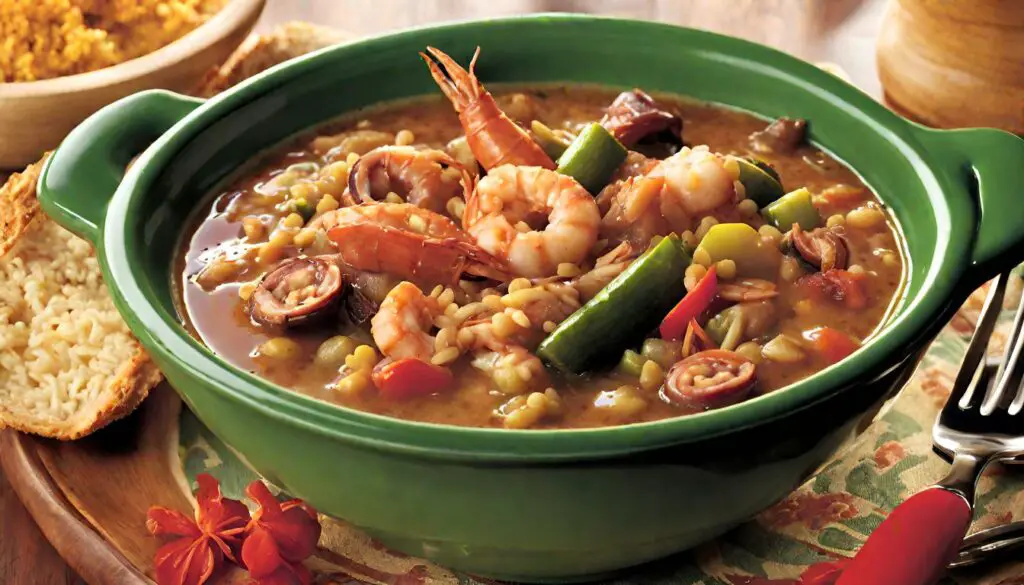
Part 4: Mastering the Art of Gumbo Cooking
Choosing the Right Equipment
To cook an authentic gumbo, selecting the right equipment is crucial. A large, heavy-bottomed pot or Dutch oven is ideal. It distributes heat evenly, crucial for making a perfect roux and simmering the gumbo without burning.
The Secret to a Perfect Roux
The roux is the heart of gumbo, and mastering it requires patience and attention. The key is to cook it slowly, stirring constantly until it reaches a deep chocolate brown color. This process can take up to an hour, but it’s the foundation of gumbo’s unique flavor.
Balancing Flavors
A great gumbo is all about balance. It’s important to taste as you go, adjusting seasonings to find the perfect harmony between spicy, savory, and smoky. Remember, gumbo is a personal dish, and each cook’s version is a reflection of their palate.
Timing is Everything
Adding ingredients in the right order and at the right time is essential. The meats need to be browned first, then the vegetables, followed by the liquids. Seafood should be added towards the end, as it cooks quickly and can easily become tough.
The Role of Patience in Gumbo Cooking
Patience is a virtue, especially when it comes to gumbo. Rushing the process can lead to underdeveloped flavors or a burnt roux. Slow cooking allows each ingredient to fully express its flavor, creating a deep, complex final product.
Storing and Reheating Gumbo
Properly storing and reheating gumbo is key to enjoying it to its fullest. It can be refrigerated for up to three days or frozen for longer storage. When reheating, do so gently, stirring frequently to maintain its texture and flavor.
Sharing the Gumbo Experience
Gumbo is meant to be shared. It’s a dish that brings people together, creating a sense of community and warmth. Whether shared with family, friends, or neighbors, gumbo is a way to connect and share a piece of Southern culture.

Part 5: The Nutritional Aspects of Gumbo
Understanding Gumbo’s Nutritional Profile
Gumbo, with its blend of meats, vegetables, and spices, offers a diverse nutritional profile. It’s a source of protein, fiber, vitamins, and minerals. However, the nutritional value can vary depending on the ingredients used, making it adaptable to different dietary needs.
Balancing Health and Flavor
Creating a healthier gumbo without sacrificing flavor is possible. Opting for lean meats, increasing the proportion of vegetables, and using low-sodium broths can make gumbo a nutritious part of a balanced diet.
Catering to Dietary Restrictions
Gumbo can be easily modified to cater to various dietary restrictions. Gluten-free roux alternatives, vegetarian and vegan versions, and adjustments for low-carb diets can all be implemented without losing the essence of the dish.
The Benefits of Seafood in Gumbo
When seafood is included, gumbo becomes a great source of omega-3 fatty acids, especially beneficial for heart health. Shrimp and fish add lean protein, making the dish both nutritious and satisfying.
Spices: A Boost of Antioxidants
The spices in gumbo, like cayenne pepper and paprika, not only add flavor but also provide antioxidants. These compounds have anti-inflammatory properties and can contribute to overall health.
Gumbo’s Role in a Balanced Diet
Incorporating gumbo into a balanced diet can provide a satisfying and hearty meal. It’s important to consider portion sizes and balance the dish with other food groups to maintain nutritional harmony.
The Joy of Healthy Eating with Gumbo
Enjoying gumbo as part of a healthy diet emphasizes the joy of eating. It’s a dish that can be both comforting and nourishing, showcasing that healthy eating doesn’t have to be bland or restrictive.
Part 6: Gumbo’s Place in World Cuisine
Gumbo’s Journey Beyond the American South
Gumbo may have its roots in the American South, but its journey has taken it far beyond. In kitchens around the world, chefs and home cooks have embraced gumbo, each adding their unique cultural twist to this classic dish.
Global Variations of Gumbo
From the addition of exotic spices in Asian-inspired versions to the incorporation of unique local ingredients in European countries, gumbo has shown remarkable versatility. These global interpretations celebrate the universal appeal of a hearty, flavorful stew.
The Influence of Gumbo in International Cuisine
Gumbo’s influence is evident in the way it has inspired chefs globally to experiment with similar cooking techniques and flavor profiles. It has sparked a curiosity about Cajun and Creole cultures, fostering a greater appreciation for their culinary traditions.
Learning from Gumbo’s Adaptability
Gumbo’s adaptability in various culinary contexts is a lesson in the power of fusion cooking. It demonstrates how traditional dishes can be respectfully adapted, resulting in new, exciting culinary creations.
Celebrating Cultural Exchange through Gumbo
Each bowl of gumbo, whether served in Louisiana or halfway across the world, is a celebration of cultural exchange. It’s a dish that brings people together, bridging cultural gaps and creating shared experiences.
Gumbo Festivals and Culinary Events
Gumbo festivals and culinary events have sprung up globally, showcasing the dish’s popularity and versatility. These events are not just celebrations of gumbo but also gatherings that honor the rich tapestry of cultures that contributed to its creation.
The Future of Gumbo in World Cuisine
As gumbo continues to travel and evolve, its future in world cuisine looks bright. It will continue to inspire, comfort, and bring people together, making it a timeless dish with universal appeal.
Part 7: Embracing Gumbo recipe in Modern Culinary Trends
Gumbo in the Health-Conscious Era
As the world becomes more health-conscious, gumbo has adapted. Chefs and home cooks are creating lighter versions, focusing on fresh, organic ingredients while maintaining the dish’s hearty essence. This shift showcases gumbo’s ability to evolve with changing dietary preferences.
Fusion Gumbo recipe: A Blend of Traditions
The trend of fusion cuisine has embraced gumbo, combining its traditional elements with flavors from other culinary traditions. This fusion approach leads to innovative dishes that honor gumbo’s heritage while introducing new taste experiences.
Sustainability and Gumbo
Sustainability is increasingly crucial in cooking, and gumbo is part of this movement. Using locally sourced and seasonal ingredients not only supports local economies but also reduces the environmental impact, making gumbo a responsible culinary choice.
The Rise of Vegetarian and Vegan Gumbo recipes
Vegetarian and vegan versions of gumbo are gaining popularity, reflecting a broader trend towards plant-based diets. These versions use meat alternatives and rich vegetable broths, proving that gumbo’s soulful flavor doesn’t rely solely on meat.
Gumbo and the Slow Food Movement
Gumbo aligns perfectly with the slow food movement, emphasizing traditional cooking methods, quality ingredients, and taking time to enjoy food. This approach resonates with those seeking a deeper connection to their food and its origins.
The Role of Social Media in Popularizing Gumbo
Social media has played a significant role in popularizing gumbo, with countless recipes and cooking demonstrations available online. This exposure has introduced gumbo to new audiences, sparking interest in its rich history and diverse variations.
Gumbo’s Future in the Culinary World
As culinary trends evolve, so will gumbo. Its ability to adapt while maintaining its core identity suggests that gumbo will continue to be a beloved dish for generations, both in the American South and beyond.
Conclusion:
Gumbo, with its deep roots and ability to adapt, remains a vibrant and relevant part of modern cuisine. It’s a dish that embodies tradition and innovation, comfort and creativity, making it a timeless favorite in the ever-evolving culinary landscape.


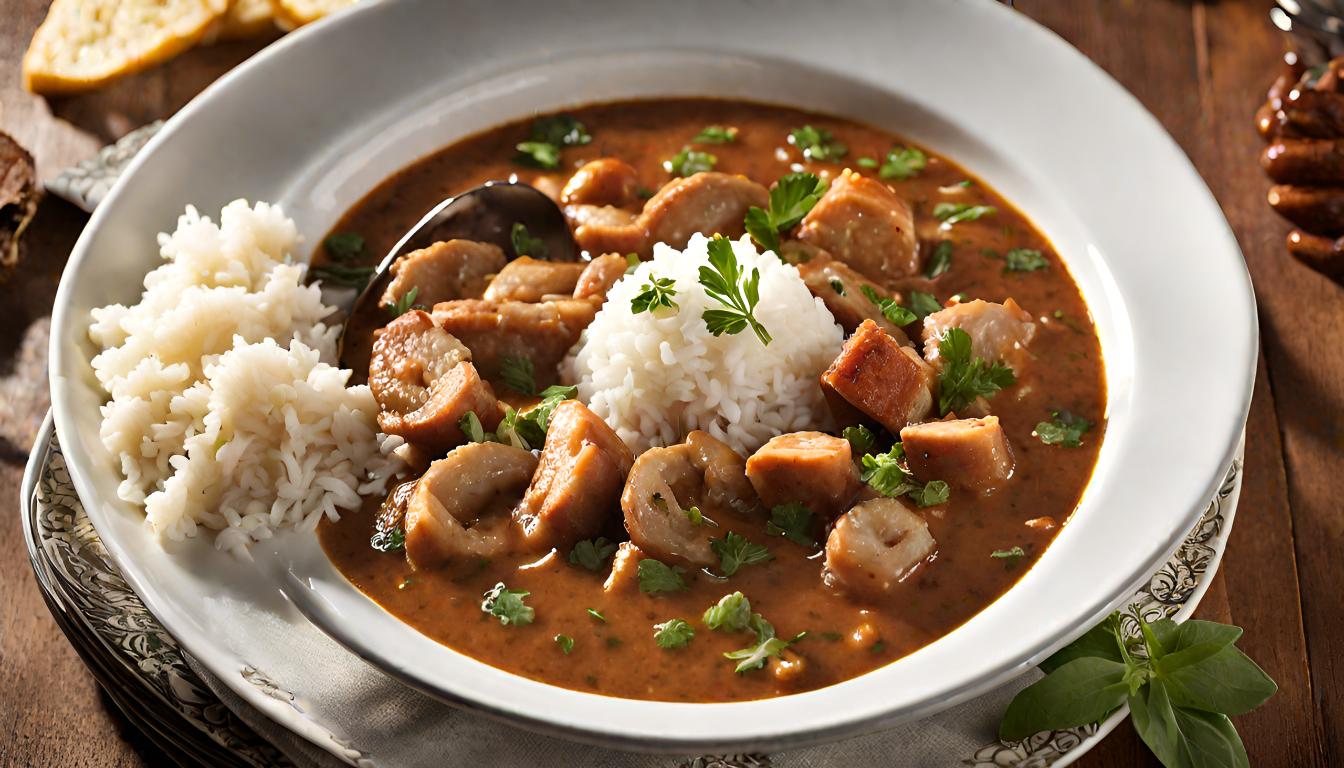
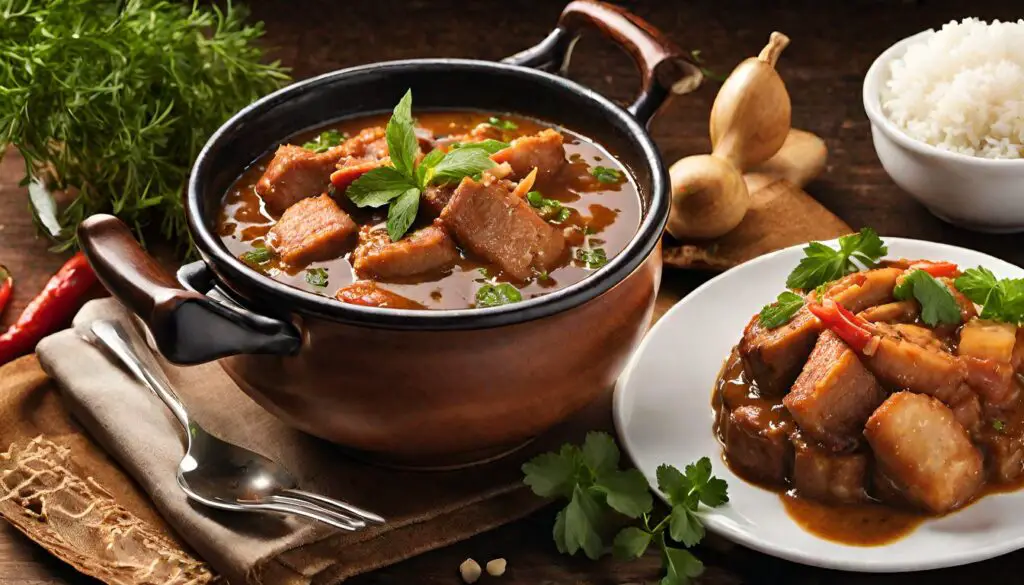
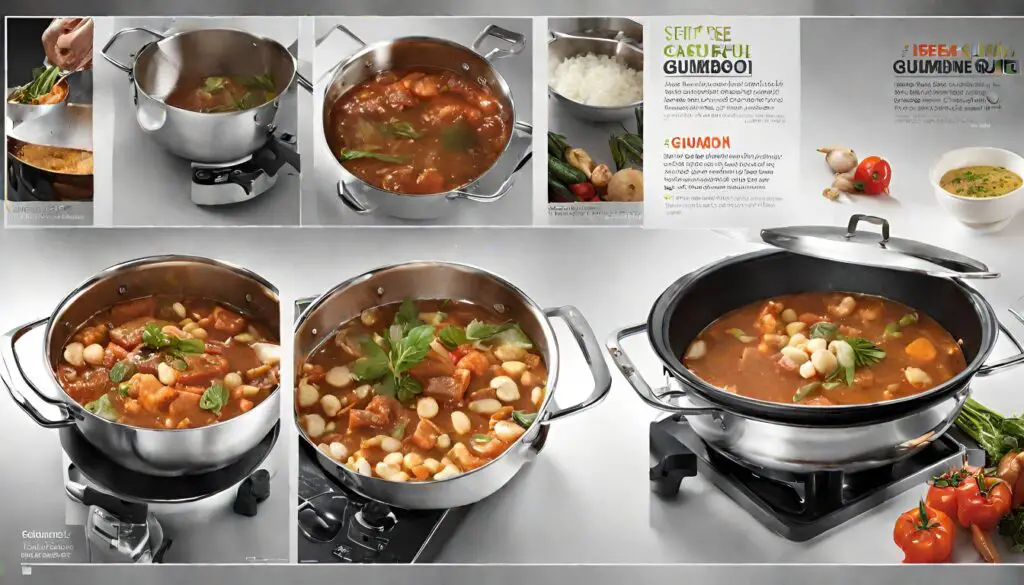
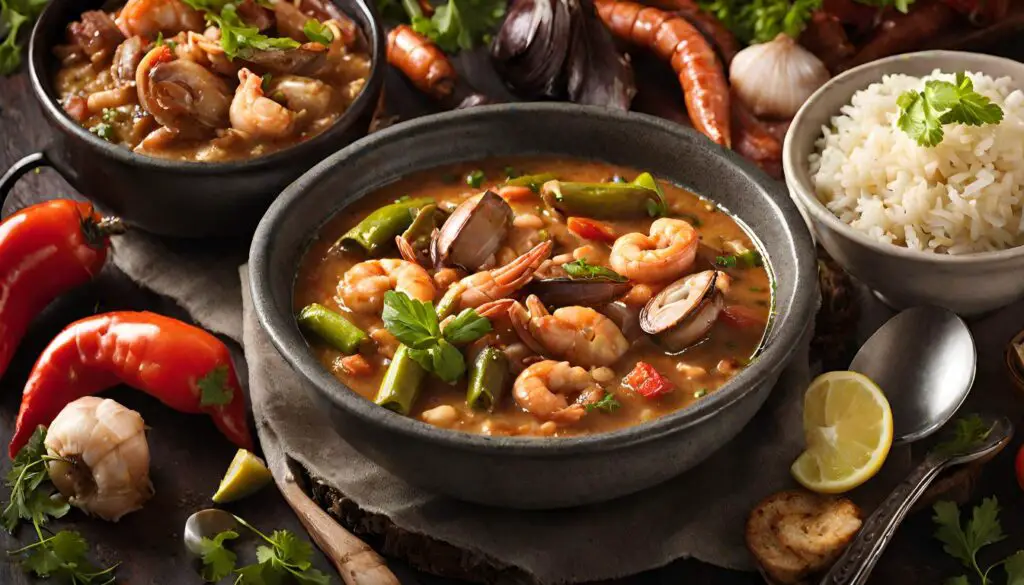



Comments are closed.